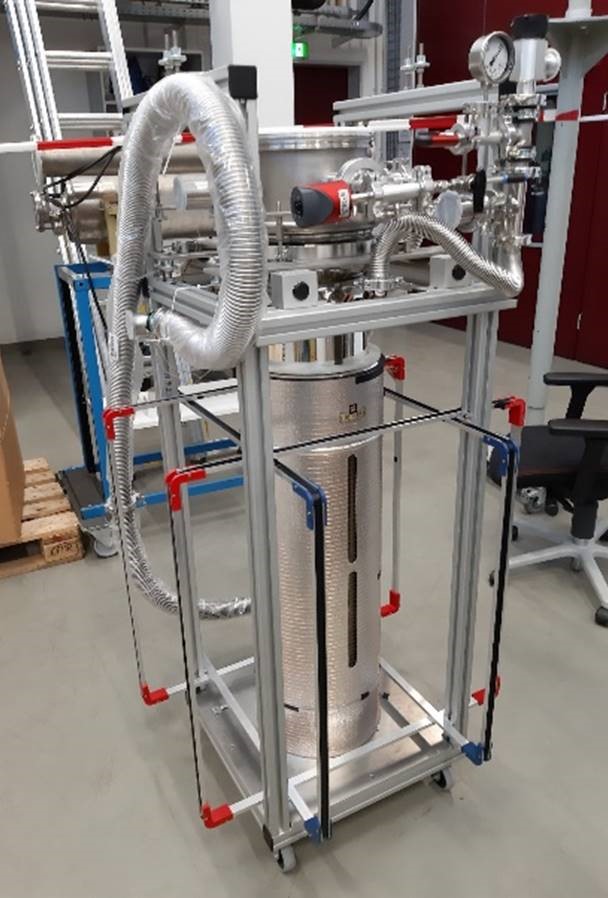Institute Science and Technology of Accelerating Systems
NOVALIS
Overall scope of the project
The proposed project aims at significantly reducing the operational power losses of superconducting radio-frequency (SRF) cavities, while also increasing the accelerating field to the range of 50-100MV/m, inaccessible with currently available resonators made from bulk Niobium (Nb). The envisaged performance increase will be achieved by coating the cavity’s inner surface with thin layers of new SRF materials capable of outperforming Nb, thus leading to higher fields and a lower surface resistance. The benefit of this approach will be twofold: First lower power losses would enable to increase the duty cycle of pulsed machines and allow for high-field continuous-wave operation with tolerable power losses, and second higher accelerating fields would increase the energy reach for existing machines and reduce the cost for novel light sources to be build.
So far, Niobium is the state-of-the-art material for SRF cavities. Its performance has been near perfected over the last decades and has been responsible for many of the successes of modern accelerators. However, Niobium cavities are now operating near their theoretical limit and only minor improvements are realistic. In particular, the achievable acceleration field is limited to less than 50 MV/m and the required cooling, often at 2 K, requires large, complex and costly cryoplants. This limits the implementation of Nb-based SRF systems to larger facilities requiring dedicated SRF experience.
To achieve a breakthrough in this field, a “beyond niobium” research is now mandatory, to realize planned upgrades of existing or the construction of future accelerators. Related R&D work will be pursued in this project: Coating the inner surface of Nb cavities by films or multilayers of superconductors with higher critical temperatures and magnetic fields can produce composite accelerator cavities which can outperform the best Nb cavities and achieve lower RF losses, ideally at higher operating temperature and higher accelerating fields potentially surpassing 50 MV/m.
In the last few years it has been proven, that in principle materials such as Nb3Sn and multilayer superconductors indeed have the potential to outperform Nb. A concerted effort is now needed to move from proof-of-principle demonstrations towards implementation, and NOVALIS will develop more performant, efficient, and affordable technologies to do so. In this crucial moment for accelerator development, NOVALIS will continue the success of the BMBF research cooperation SMART. The SMART collaboration underscored that a wide spectrum of expertise is indeed required, as can only be provided by the sum of all partners is indeed required to address the many challenges, from materials science to RF simulations to in-depth testing expertise.
To achieve its goals and thus improving accelerator technology for future efficient light sources, NOVALIS will explore new theoretical concepts, use state-of-the-art surface analysis techniques and innovative BCS characterization systems all of which rapidly feedback on coating studies. These techniques are vital to help accelerate the prototyping of coating technologies beyond the current proof-of-principle.
Scientific and technical objectives of the project
In this project, we aim at further improving the performance of superconducting cavities by coating their inner surface with an alternating sequence of thin insulating and superconducting layers. To achieve a significant performance increase, five strategic objectives are defined:
-
SMART was successful at ALD coating and testing a cavity with an Al2O3 insulator. This proof-of-principle experiment was a key intermediate step towards multilayer coated cavities. For the next step, the coating with a superconductor requires the design and installation of a Plasma-Enhanced Atomic Layer Deposition system (PE-ALD). Such a system allows coating of a single-cell cavity with compounds like NbTiN, NbN and AlN with the required film properties and hence, is a major objective.
-
To compare the behavior of coated cavities with regular niobium cavities and identify potentially mandatory pre- or post-processing steps of those layers, magnetic flux trapping & field emission properties of samples will be studied. These properties are crucial for a realistic estimate of the expected performance and will be measured in dedicated set-ups.
-
The improvements in tailoring superconducting layers of high quality, also driven by SMART, helped to extend the focus to the insulator itself and the interfaces, and hence interactions, to both superconductors. Therefore, we will carry out material, RF and numerical studies of this layer to further improve the multilayer system.
-
To correlate material properties with RF BCS properties extensive RF testing is required. Two of the world-wide four Quadrupole Resonators (QPR) are available within this collaboration for the most in-depth studies possible (“gold standard”). To complement the QPR, a novel fast turn-around system for the same samples is to be constructed. By reducing the characterization to surface resistance vs. temperature at one frequency and low-field it can much more rapidly “pre-select” good films for efficient film development. When the most promising recipes are subsequently applied to cavities, they will be RF tested characterized with novel temperature and magnetomapping techniques.
-
To push the potential of this approach, another superconducting material, namely MgB2 will be studied. MgB2 has material parameters which promise an even more significant improvement of SRF cavities’ properties compared with any other currently studied material. This “blue-sky” research can be covered by the NOVALIS network almost naturally, as it is already perfectly suited for such fundamental studies on this relatively new and interesting material for SRF. Thus, the suitability of MgB2 for future studies can be explored.
These highly interlinked objectives are to be studied in various work packages. These work packages form a logical continuation of the research work carried out in the predecessor BMBF research cooperation SMART. The results obtained and knowledge gained so far, the infrastructure developed and the networks created through the funding are the basis for the achievement of these goals.

